Complete Solutions to Exercises (Linked Comprehension) of chapter SOLUTIONS of Class 12 book with complete answers and questions
| Class 12 | CHEMISTRY |
| Chapter | SOLUTIONS |
| CENGAGE CHEMISTRY | Exercises (Linked Comprehension) |
| Number Of Questions | 58 |
| Academic Year | 2023-24 |
An aqueous solution freezes at 272.4 K while pure water freezes at 273 K. Given `K_(f)=1.86 K kg "mol"^(-1)`,`K_(b)=0.512 K kg "mol"^(-1)` and vapour pressure of water at 298 K = 23.756 mm Hg. Determine the following.
Molality of the solution is00:53View SolutionAn aqueous solution freezes at 272.4 K while pure water freezes at 273 K. Given `K_(f)=1.86 K kg "mol"^(-1)`,`K_(b)=0.512 K kg "mol"^(-1)` and vapour pressure of water at 298 K = 23.756 mm Hg. Determine the following.
Boiling point of the solution is01:34View SolutionAn aqueous solution freezes at 272.4 K while pure water freezes at 273 K. Given `K_(f)=1.86 K kg "mol"^(-1)`,`K_(b)=0.512 K kg "mol"^(-1)` and vapour pressure of water at 298 K = 23.756 mm Hg. Determine the following.
Lowering in vapour pressure at 298 K is05:02View SolutionAn aqueous solution freezes at 272.4 K while pure water freezes at 273 K. Given `K_(f)=1.86 K kg "mol"^(-1)`,`K_(b)=0.512 K kg "mol"^(-1)` and vapour pressure of water at 298 K = 23.756 mm Hg. Determine the following.
Depression in freezing point of solution00:32View SolutionA solution of sucrose (molar mass =342) is prepared by dissolving 688.4 g in 1000 g of water. Calculate
The vapour pressure of solution at 293 K.03:39View SolutionA solution of sucrose (molar mass =342) is prepared by dissolving 68.4 g in 1000 g of water. Calculate
The boiling point of solution.03:02View SolutionA solution of sucrose (molar mass =342) is prepared by dissolving 68.4 g in 1000 g of water. Calculate
The freezing point of solution.02:18View SolutionA solution of sucrose (molar mass =342) is prepared by dissolving 68.2 g in 1000 g of water. Calculate
The osmotic pressure at 273 K.02:17View SolutionThe osomotic pressure `pi` depends on the molar concentration of the solution `(pi=CRT)`. If two solutions are of equal solute concentration and, hence, have the same omotic pressure, they are said to be isotonic. If two solutions are of unequal osmotic pressures, the more concentrated solution is said to be hypertonic and the more diluted solution is described as hypotonic.
Osmosis is the major mechanism for transporting water upward in the plants. Answer the following questions:
A plant cell shrinks when it is kept in:01:12View SolutionThe osomotic pressure `pi` depends on the molar concentration of the solution `(pi=CRT)`. If two solutions are of equal solute concentration and, hence, have the same omotic pressure, they are said to be isotonic. If two solutions are of unequal osmotic pressures, the more concentrated solution is said to be hypertonic and the more diluted solution is described as hypotonic.
Osmosis is the major mechanism for transporting water upward in the plants. Answer the following questions:
What would be the percent strength of solution of urea that would be isotonic with `4.5%` solution of glucose?03:40View SolutionThe osomotic pressure `pi` depends on the molar concentration of the solution `(pi=CRT)`. If two solutions are of equal solute concentration and, hence, have the same omotic pressure, they are said to be isotonic. If two solutions are of unequal osmotic pressures, the more concentrated solution is said to be hypertonic and the more diluted solution is described as hypotonic.
Osmosis is the major mechanism for transporting water upward in the plants. Answer the following questions:
The glucose solution to be injected into the bloodstream and the blood itself should have the same.01:13View SolutionThe osomotic pressure `pi` depends on the molar concentration of the solution `(pi=CRT)`. If two solutions are of equal solute concentration and, hence, have the same omotic pressure, they are said to be isotonic. If two solutions are of unequal osmotic pressures, the more concentrated solution is said to be hypertonic and the more diluted solution is described as hypotonic.
Osmosis is the major mechanism for transporting water upward in the plants. Answer the following questions:
Isotonic solutions have same00:33View SolutionThe osomotic pressure `pi` depends on the molar concentration of the solution `(pi=CRT)`. If two solutions are of equal solute concentration and, hence, have the same omotic pressure, they are said to be isotonic. If two solutions are of unequal osmotic pressures, the more concentrated solution is said to be hypertonic and the more diluted solution is described as hypotonic.
Osmosis is the major mechanism for transporting water upward in the plants. Answer the following questions:
Osmotic rise of a solution depends on00:52View SolutionThe solution which boil at constant temperature like a pure liquid and possess same composition in liquid as well as vapour state are called azeotropes. The components of azetropes cannot be separated by fractional distillation. Only non-ideal solutions form azeotropes. Solutions with negative deviation form maximum boiling azeotrope and the solutions with positive deviation form minimum boiling azeotrope. The boiling point of an azeotrope is never equal to the boiling points of any of the components of the azeotrope.
Answer the following question:
The azeotropic solutions of two miscible liquids05:39View SolutionThe solution which boil at constant temperature like a pure liquid and possess same composition in liquid as well as vapour state are called azeotropes. The components of azetropes cannot be separated by fractional distillation. Only non-ideal solutions form azeotropes. Solutions with negative deviation form maximum boiling azeotrope and the solutions with positive deviation form minimum boiling azeotrope. The boiling point of an azeotrope is never equal to the boiling points of any of the components of the azeotrope.
Answer the following question:
The azeotropic solutions of two miscible liquids
Solutions which distill without any change in composition or temperature are called02:09View SolutionThe solution which boil at constant temperature like a pure liquid and possess same composition in liquid as well as vapour state are called azeotropes. The components of azetropes cannot be separated by fractional distillation. Only non-ideal solutions form azeotropes. Solutions with negative deviation form maximum boiling azeotrope and the solutions with positive deviation form minimum boiling azeotrope. The boiling point of an azeotrope is never equal to the boiling points of any of the components of the azeotrope.
Answer the following question:
The azeotropic solutions of two miscible liquids
The azeotropic mixture of water and `HCl` boils at `108.5^(@)C`. This solution is01:32View SolutionThe solution which boil at constant temperature like a pure liquid and possess same composition in liquid as well as vapour state are called azeotropes. The components of azetropes cannot be separated by fractional distillation. Only non-ideal solutions form azeotropes. Solutions with negative deviation form maximum boiling azeotrope and the solutions with positive deviation form minimum boiling azeotrope. The boiling point of an azeotrope is never equal to the boiling points of any of the components of the azeotrope.
Answer the following question:
The azeotropic solutions of two miscible liquids
`100 mL` of liquid `A` and `50 mL` of liquid `B` are mixed to form `138 mL` solution. It is01:41View SolutionThe solution which boil at constant temperature like a pure liquid and possess same composition in liquid as well as vapour state are called azeotropes. The components of azetropes cannot be separated by fractional distillation. Only non-ideal solutions form azeotropes. Solutions with negative deviation form maximum boiling azeotrope and the solutions with positive deviation form minimum boiling azeotrope. The boiling point of an azeotrope is never equal to the boiling points of any of the components of the azeotrope.
Answer the following question:
The azeotropic solutions of two miscible liquids
Which among the following combinations is a maximum boiling azeotrope?01:11View SolutionA `1.24 M` aqueous solution of `KI` has density of `1.15 g cm^(-3)`.
Answer the following questions about this solution:
The percentage composition of solute in the solution is03:03View SolutionA `1.24 M` aqueous solution of `KI` has density of `1.15 g cm^(-3)`.
Answer the following questions about this solution:
The molality of this solution will be03:31View SolutionA 1.24 M aqueous solution of KI has a density of `1.15 gcm^(−3)`. What is the freezing point of the solution if the KI is completely dissociated in the solution?
06:04View SolutionA `1.24 M` aqueous solution of `KI` has density of `1.15 g cm^(-3)`.
Answer the following questions about this solution:
The experimental freezing point of the solution is `-4.46^(@)C`.
What percentage of `KI` is dissociated?09:02View SolutionA `1.24 M` aqueous solution of `KI` has density of `1.15 g cm^(-3)`.
Answer the following questions about this solution:
The normality of the solution is00:40View SolutionThe electrolyte solutions show abnormal colligative porperties.To account for this effect we define a quantity called the Van't Hoff factor given by
`i=("Actual number of particles in solution after dissociation")/("Number of formula units initially dissolved in solution")`
`i=1 ("for non-electrolytes")`
`igt1 ("for electrolytes, undergoing dissociation")`
`ilt1 ("for solutes, undergoing association")`
Answer the following questions:
Benzoic acid undergoes dimerization in bezene solution. The Van't Hoff factor `i` for the solutions is00:47View SolutionThe electrolyte solutions show abnormal colligative porperties.To account for this effect we define a quantity called the Van't Hoff factor given by
`i=("Actual number of particles in solution after dissociation")/("Number of formula units initially dissolved in solution")`
`i=1 ("for non-electrolytes")`
`igt1 ("for electrolytes, undergoing dissociation")`
`ilt1 ("for solutes, undergoing association")`
Answer the following questions:
certain substances trimerize when dissolved in a solvent `A`. The Van't Hoff factor `i` for the solutions is01:29View SolutionThe electrolyte solutions show abnormal colligative porperties.To account for this effect we define a quantity called the Van't Hoff factor given by
`i=("Actual number of particles in solution after dissociation")/("Number of formula units initially dissolved in solution")`
`i=1 ("for non-electrolytes")`
`igt1 ("for electrolytes, undergoing dissociation")`
`ilt1 ("for solutes, undergoing association")`
Answer the following questions:
For a solution of a non-electrolyte in water, the Van't Hoff factor is00:51View SolutionThe electrolyte solutions show abnormal colligative porperties.To account for this effect we define a quantity called the Van't Hoff factor given by
`i=("Actual number of particles in solution after dissociation")/("Number of formula units initially dissolved in solution")`
`i=1 ("for non-electrolytes")`
`igt1 ("for electrolytes, undergoing dissociation")`
`ilt1 ("for solutes, undergoing association")`
Answer the following questions:
`0.1 M K_(4)[Fe(CN)_(6)]` is `60%` ionized. What will be its Van't Hoff factor?01:31View SolutionThe electrolyte solutions show abnormal colligative porperties.To account for this effect we define a quantity called the Van't Hoff factor given by
`i=("Actual number of particles in solution after dissociation")/("Number of formula units initially dissolved in solution")`
`i=1 ("for non-electrolytes")`
`igt1 ("for electrolytes, undergoing dissociation")`
`ilt1 ("for solutes, undergoing association")`
Answer the following questions:
A solution of benzoic acid is dissolved in benzene such that it undergoes molecular association and its molar mass apporaches `244`. The benzoic molecules will exist as01:10View Solution
Compartment `A` and `B` have the following combinations of solution:
`{:(,A,B),(1,0.1 M KCl,0.2 M KCl),(2,0.1%(m//V) NaCl,10% (m//V) NaCl),(3,18 gL^(-1) "glucose",34.2 gL^(-1) "sucrose"),(3,20% (m//V) "glucose",10% (m//V) "glucose"):}`
Answer the following question:
Indicate the number of solutions which is/are isotonic.11:29View Solution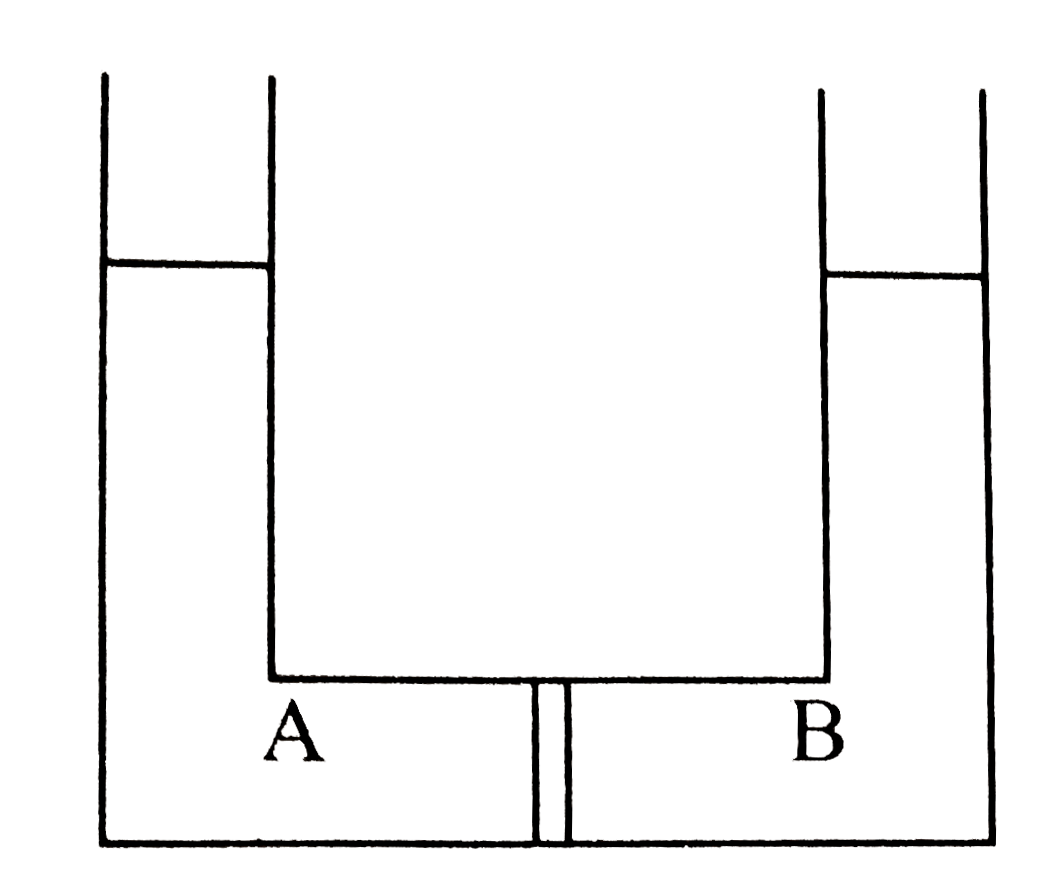
Compartment `A` and `B` have the following combinations of solution:
`{:(,A,B),(1,0.1 M KCl,0.2 M KCl),(2,0.1%(m//V) NaCl,10% (m//V) NaCl),(3,18 gL^(-1) "glucose",34.2 gL^(-1) "sucrose"),(3,20% (m//V) "glucose",10% (m//V) "glucose"):}`
The solutions in which compartment `B` is hypertonic.08:40View Solution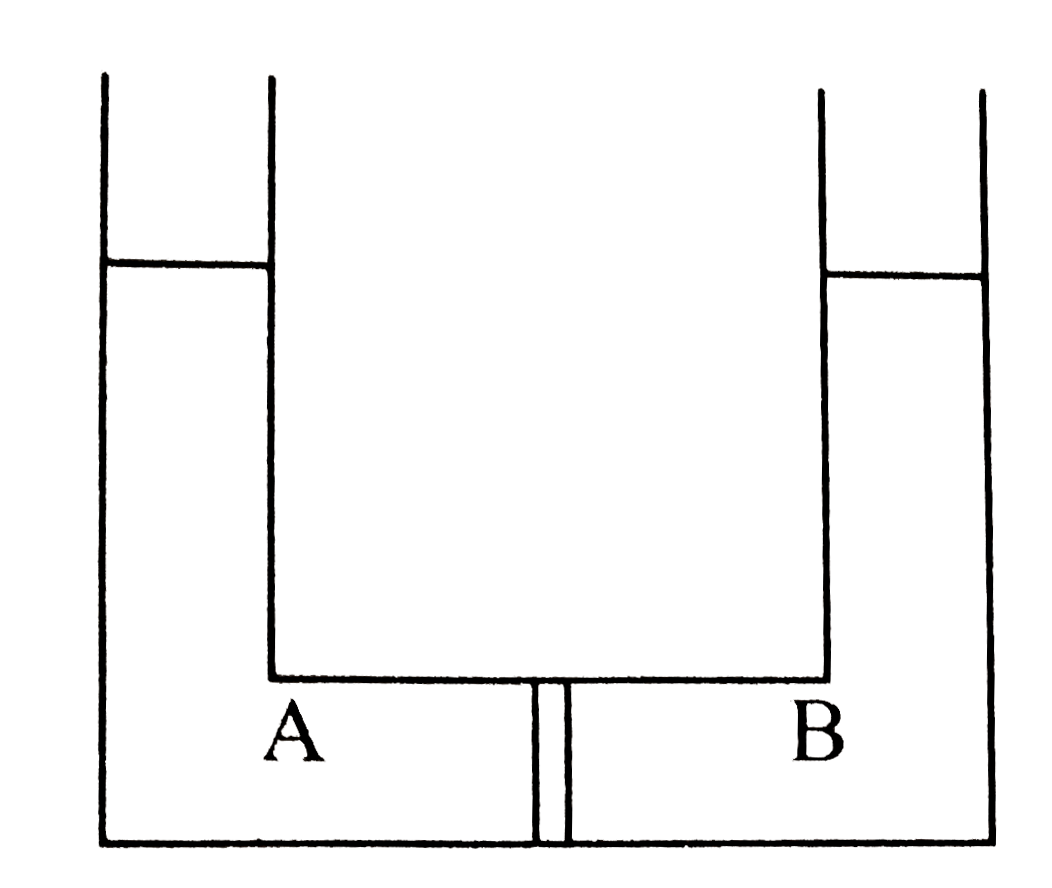
Compartment `A` and `B` have the following combinations of solution:
`{:(,A,B),(1,0.1 M KCl,0.2 M KCl),(2,0.1%(m//V) NaCl,10% (m//V) NaCl),(3,18 gL^(-1) "glucose",34.2 gL^(-1) "sucrose"),(3,20% (m//V) "glucose",10% (m//V) "glucose"):}`
Indicate the solution(s) in which compartment `A` will show an increases in volume.07:38View Solution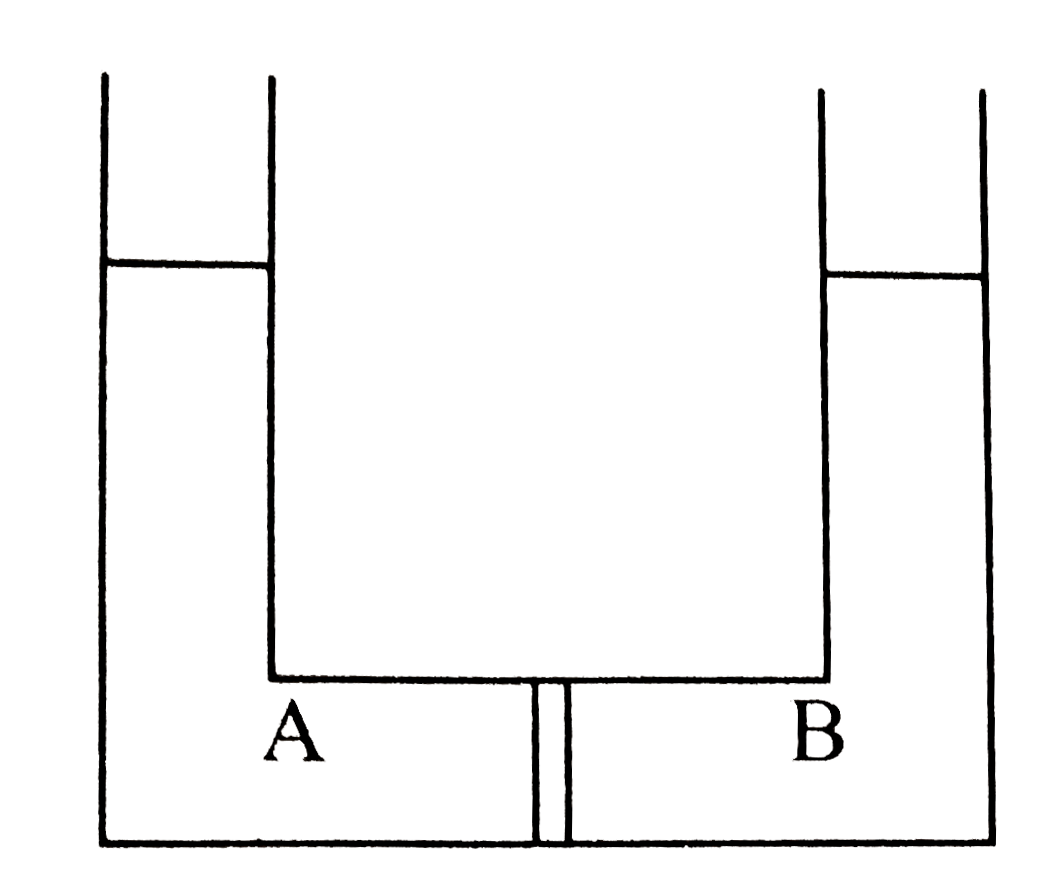
Compartment `A` and `B` have the following combinations of solution:
`{:(,A,B),(1,0.1 M KCl,0.2 M KCl),(2,0.1%(m//V) NaCl,10% (m//V) NaCl),(3,18 gL^(-1) "glucose",34.2 gL^(-1) "sucrose"),(4,20% (m//V) "glucose",10% (m//V) "glucose"):}`
Indicate the solution(s) in which compartment `B` will show an increases in volume.
1) `1,2,4`
2) `1,2`
3) `2,3`
4) `3,4`08:59View Solution
Compartment `A` and `B` have the following combinations of solution:
`{:(,A,B),(1,0.1 M KCl,0.2 M KCl),(2,0.1%(m//V) NaCl,10% (m//V) NaCl),(3,18 gL^(-1) "glucose",34.2 gL^(-1) "sucrose"),(3,20% (m//V) "glucose",10% (m//V) "glucose"):}`
Answer the following question:
Indicate the number of solutions which is/are isotonic.11:29View SolutionThe boiling point elevation and freezing point depression of solutions have a number of partical applications. Ethylene glycol `(CH_(2)OH-CH_(2)OH)` is used in automobile radiatiors as an antifreeze because it lowers the freezing point of the coolant. The same substance also helps to prevent the radiator coolant from boiling away by elevating the boiling point. Ethylene glycol has low vapour pressure. We can also use glycerol as an antifreeze. In order for the boiling point elevation to occur, the solute must be non-volatile, but no such restriction applies to freezing point depression. For example, methanol `(CH_(3)OH)`, a fairly volatile liquid that boils only at `65^(@)C`, is sometimes used as an antifreeze in automobile radiators.
Which of the following is a better reagent for depression in freezing point but not for elevation in boiling point?01:46View SolutionThe boiling point elevation and freezing point depression of solutions have a number of partical applications. Ethylene glycol (CH_(2)OH-CH_(2)OH) is used in automobile radiatiors as an antifreeze because it lowers the freezing point of the coolant. The same substance also helps to prevent the radiator coolant from boiling away by elevating the boiling point. Ethylene glycol has low vapour pressure. We can also use glycerol as an antifreeze. In order for the boiling point elevation to occur, the solute must be non-volatile, but no such restriction applies to freezing point depression. For example, methanol (CH_(3)OH), a fairly volatile liquid that boils only at 65^(@)C, is sometimes used as an antifreeze in automobile radiators.
`124 g` each of the two reagents glycol and glycerol are added in `5 kg` of water of the radiators in two cars. Which of the following statements is wrong?
(a)Both will act as antifreeze.
(b)Glycol will be better.
(c)Glycerol is better because its molar mass is greater than glycol.
(d)all of these02:47View SolutionThe boiling point elevation and freezing point depression of solutions have a number of partical applications. Ethylene glycol `(CH_(2)OH-CH_(2)OH)` is used in automobile radiatiors as an antifreeze because it lowers the freezing point of the coolant. The same substance also helps to prevent the radiator coolant from boiling away by elevating the boiling point. Ethylene glycol has low vapour pressure. We can also use glycerol as an antifreeze. In order for the boiling point elevation to occur, the solute must be non-volatile, but no such restriction applies to freezing point depression. For example, methanol `(CH_(3)OH)`, a fairly volatile liquid that boils only at `65^(@)C`, is sometimes used as an antifreeze in automobile radiators.
`620 g` glycol is added to `4 kg` water in the radiator of car. What amount of ice will separate out at `-6^(@)C`?03:57View SolutionThe boiling point elevation and freezing point depression of solutions have a number of partical applications. Ethylene glycol `(CH_(2)OH-CH_(2)OH)` is used in automobile radiatiors as an antifreeze because it lowers the freezing point of the coolant. The same substance also helps to prevent the radiator coolant from boiling away by elevating the boiling point. Ethylene glycol has low vapour pressure. We can also use glycerol as an antifreeze. In order for the boiling point elevation to occur, the solute must be non-volatile, but no such restriction applies to freezing point depression. For example, methanol `(CH_(3)OH)`, a fairly volatile liquid that boils only at `65^(@)C`, is sometimes used as an antifreeze in automobile radiators.
If the cost of glycerol, glycol, and methanol is same, then the sequence of economy to use these compounds as antifreeze will be02:44View SolutionThe boiling point elevation and freezing point depression of solutions have a number of partical applications. Ethylene glycol `(CH_(2)OH-CH_(2)OH)` is used in automobile radiatiors as an antifreeze because it lowers the freezing point of the coolant. The same substance also helps to prevent the radiator coolant from boiling away by elevating the boiling point. Ethylene glycol has low vapour pressure. We can also use glycerol as an antifreeze. In order for the boiling point elevation to occur, the solute must be non-volatile, but no such restriction applies to freezing point depression. For example, methanol `(CH_(3)OH)`, a fairly volatile liquid that boils only at `65^(@)C`, is sometimes used as an antifreeze in automobile radiators.
Which among the following is the most volatile and the best antifreeze?01:55View SolutionProperties such as boiling point, freezing point, and vapour pressure of a pure solvent change when solute molecules are added to get homogeneous solution. These are called colligative properties. Applications of colligative properties are very useful in day-tөday life. One of the examples is the use of the mixture of ethylene glycol and water as an anti-freezing liquid in the radiator of automobiles. A solution `M` is prepared by mixing ethanol and water. The mole fraction of ethanol in the mixture is `0.9`.
Given: Freezing point depression constant of water
`K_(f)^(water)=1.86 K kg mol^(-1)`
Freezing point depression constant of ethanol
`K_(f)^(ethanol)=2.0 K kg mol^(-1)`
Boiling point elevation constant of water
`K_(b)^(water)=2.52 K kg mol^(-1)`
Boiling point elevation constant of ethanol
`K_(b)^(ethanol)=1.2 K kg mol^(-1)`
Standard freezing point of water = `273 K`
Standard freezing point of ethanol = `155.7 K`
Standard boiling point of water = `373 K`
Standard boiling point of ethanol = `315.5 K`
Vapour pressure of pure water =`32.8 mm Hg`
Vapour pressure of pure ethanol=`40 mm Hg`
Molecular weight of water =`18 g mol^(-1)`
Molecular weight of ethanol =`46 g mol^(-1)`
In answering the following questions, consider the solutions to be ideal dilute solutions and solutes to be non-volatile and non-dissociative.
The freezing point of solution `M` is05:43View SolutionProperties such as boiling point, freezing point, and vapour pressure of a pure solvent change when solute molecules are added to get homogeneous solution. These are called colligative properties. Applications of colligative properties are very useful in day-tөday life. One of the examples is the use of the mixture of ethylene glycol and water as an anti-freezing liquid in the radiator of automobiles. A solution `M` is prepared by mixing ethanol and water. The mole fraction of ethanol in the mixture is `0.9`.
Given: Freezing point depression constant of water
`K_(f)^(water)=1.86 K kg mol^(-1)`
Freezing point depression constant of ethanol
`K_(f)^(ethanol)=2.0 K kg mol^(-1)`
Boiling point elevation constant of water
`K_(b)^(water)=2.52 K kg mol^(-1)`
Boiling point elevation constant of ethanol
`K_(b)^(ethanol)=1.2 K kg mol^(-1)`
Standard freezing point of water = `273 K`
Standard freezing point of ethanol = `155.7 K`
Standard boiling point of water = `373 K`
Standard boiling point of ethanol = `315.5 K`
Vapour pressure of pure water =`32.8 mm Hg`
Vapour pressure of pure ethanol=`40 mm Hg`
Molecular weight of water =`18 g mol^(-1)`
Molecular weight of ethanol =`46 g mol^(-1)`
In answering the following questions, consider the solutions to be ideal dilute solutions and solutes to be non-volatile and non-dissociative.
The vapour pressure of solution `M` is03:14View SolutionProperties such as boiling point, freezing point, and vapour pressure of a pure solvent change when solute molecules are added to get homogeneous solution. These are called colligative properties. Applications of colligative properties are very useful in day-tөday life. One of the examples is the use of the mixture of ethylene glycol and water as an anti-freezing liquid in the radiator of automobiles. A solution `M` is prepared by mixing ethanol and water. The mole fraction of ethanol in the mixture is `0.9`.
Given: Freezing point depression constant of water
`K_(f)^(water)=1.86 K kg mol^(-1)`
Freezing point depression constant of ethanol
`K_(f)^(ethanol)=2.0 K kg mol^(-1)`
Boiling point elevation constant of water
`K_(b)^(water)=2.52 K kg mol^(-1)`
Boiling point elevation constant of ethanol
`K_(b)^(ethanol)=1.2 K kg mol^(-1)`
Standard freezing point of water = `273 K`
Standard freezing point of ethanol = `155.7 K`
Standard boiling point of water = `373 K`
Standard boiling point of ethanol = `315.5 K`
Vapour pressure of pure water =`32.8 mm Hg`
Vapour pressure of pure ethanol=`40 mm Hg`
Molecular weight of water =`18 g mol^(-1)`
Molecular weight of ethanol =`46 g mol^(-1)`
In answering the following questions, consider the solutions to be ideal dilute solutions and solutes to be non-volatile and non-dissociative.
The freezing point of solution `M` is05:43View SolutionProperties such as boiling point, freezing point, and vapour pressure of a pure solvent change when solute molecules are added to get homogenous solution. These are called colligative properties.
Anwer the following questions:
i.`0.001 m NaCl`
ii.0.001 m urea
iii.`0.001 m MgCl_(2)`
iv.`0.001 m CH_(3)COOH`
Increasing order of boiling points02:21View SolutionProperties such as boiling point, freezing point, and vapour pressure of a pure solvent change when solute molecules are added to get homogenous solution. These are called colligative properties.
Anwer the following questions:
i.0.1 M ethanol
ii.`0.1 m Ba_(3)(PO_(4))_(3)`
iii.`0.1 m Na_(2)SO_(4)`
Increasing order of freezing points02:21View SolutionProperties such as boiling point, freezing point, and vapour pressure of a pure solvent change when solute molecules are added to get homogenous solution. These are called colligative properties.
Anwer the following questions:
i.0.1 M glucose
ii.1% urea solution
iii.0.1 M common salt
Increasing order of osmotic pressure03:19View SolutionProperties such as boiling point, freezing point, and vapour pressure of a pure solvent change when solute molecules are added to get homogenous solution. These are called colligative properties.
Anwer the following questions:
i. `NaNO_(3)` ii.`BaCl_(2)`
iii. `K_(3)[Fe(CN)_(6)]` iv. `C_(6)H_(12)O_(6)`
Increasing order of Van't Hoff factor01:19View SolutionA certain vessel `X` has water and nitrogen gas at a total pressure of 2 atm and `300 K`. All the contents of vessel was transferred to another vessel `Y` having half the capacity of the vessel `X`. The pressure of `N_(2)` in this vessel was 3.8 atm at `300 K`. The vessel `Y` is heated to `320 K` and the total pressure observed was 4.32 atm. Assume that the volume occupied by the gases in vessel is equal to the volume of the vessel. Calculate the following:
Pressure of `H_(2)O` in `X` at `320 K`.07:25View SolutionA certain vessel `X` has water and nitrogen gas at a total pressure of 2 atm and `300 K`. All the contents of vessel and transferred to another vessel `Y` having half the capacity of the vessel `X`. The pressure of `N_(2)` in this vessel was 3.8 atm at `300 K`. The vessel `Y` is heated to `320 K` and the total pressure observed was 4.32 atm. Assume that the volume occupied by the gases in vessel is equal to the volume of the vessel. Calculate the following:
Pressure of `H_(2)` at `320 K`.02:47View SolutionA certain vessel `X` has water and nitrogen gas at a total pressure of 2 atm and `300 K`. All the contents of vessel and transferred to another vessel `Y` having half the capacity of the vessel `X`. The pressure of `N_(2)` in this vessel was 3.8 atm at `300 K`. The vessel `Y` is heated to `320 K` and the total pressure observed was 4.32 atm. Assume that the volume occupied by the gases in vessel is equal to the volume of the vessel. Calculate the following:
Pressure of water vapour at `320 K`.02:25View SolutionA certain vessel `X` has water and nitrogen gas at a total pressure of 2 atm and `300 K`. All the contents of vessel and transferred to another vessel `Y` having half the capacity of the vessel `X`. The pressure of `N_(2)` in this vessel was 3.8 atm at `300 K`. The vessel `Y` is heated to `320 K` and the total pressure observed was 4.32 atm. Assume that the volume occupied by the gases in vessel is equal to the volume of the vessel. Calculate the following:
Enthalpy of vapourization.10:58View SolutionA system of greater disorder of molecules is more probable. The disorder of molecules is reflected by the entropy of the system. A liquid vapourizes to form a more disordered gas. When a solute is present, there is additional contribution to the entropy of the liquid due to increased randomness. As the entropy of solution is higher than that of pure liquid, there is weaker tendency to form the gas. Thus, a solute (non-volatile) lowers the vapour pressure of a liquid, and hence a higher boiling point of the solution.
Similarly, the greater randomness of the solution opposes the tendercy to freeze. In consequence, a lower temperature must be reached for achieving the equilibrium between the solid (frozen solvent) and the solution. The elevation in boiling point `(DeltaT_(b))` and depression in freezing point `(DeltaT_(f))` of a solution are the colligative properties which depend only on the concentration of particles of the solute and not their identity. For dilute solutions, `(DeltaT_(b))` and `(DeltaT_(f))` are proportional to the molarity of the solute in the solution.
Dissolution of a non-volatile solute into a liquid leads to07:49View SolutionA system of greater disorder of molecules is more probable. The disorder of molecules is reflected by the entropy of the system. A liquid vapourizes to form a more disordered gas. When a solute is present, there is additional contribution to the entropy of the liquid due to increased randomness. As the entropy of solution is higher than that of pure liquid, there is weaker tendency to form the gas. Thus, a solute (non-volatile) lowers the vapour pressure of a liquid, and hence a higher boiling point of the solution.
Similarly, the greater randomness of the solution opposes the tendercy to freeze. In consequence, a lower temperature must be reached for achieving the equilibrium between the solid (frozen solvent) and the solution. The elevation in boiling point `(DeltaT_(b))` and depression in freezing point `(DeltaT_(f))` of a solution are the colligative properties which depend only on the concentration of particles of the solute and not their identity. For dilute solutions, `(DeltaT_(b))` and `(DeltaT_(f))` are proportional to the molarity of the solute in the solution.
To aqueous solution of `Nal`, increasing amounts of solid `Hgl_(2)` is added. The vapour pressure of the solution02:30View SolutionA system of greater disorder of molecules is more probable. The disorder of molecules is reflected by the entropy of the system. A liquid vapourizes to form a more disordered gas. When a solute is present, there is additional contribution to the entropy of the liquid due to increased randomness. As the entropy of solution is higher than that of pure liquid, there is weaker tendency to form the gas. Thus, a solute (non-volatile) lowers the vapour pressure of a liquid, and hence a higher boiling point of the solution.
Similarly, the greater randomness of the solution opposes the tendercy to freeze. In consequence, a lower temperature must be reached for achieving the equilibrium between the solid (frozen solvent) and the solution. The elevation in boiling point `(DeltaT_(b))` and depression in freezing point `(DeltaT_(f))` of a solution are the colligative properties which depend only on the concentration of particles of the solute and not their identity. For dilute solutions, `(DeltaT_(b))` and `(DeltaT_(f))` are proportional to the molarity of the solute in the solution.
A liquid possessing which of the following characteristics will be most suitable for determining the molecular mass of a compound by cryoscopic measurements?View SolutionA system of greater disorder of molecules is more probable. The disorder of molecules is reflected by the entropy of the system. A liquid vapourizes to form a more disordered gas. When a solute is present, there is additional contribution to the entropy of the liquid due to increased randomness. As the entropy of solution is higher than that of pure liquid, there is weaker tendency to form the gas. Thus, a solute (non-volatile) lowers the vapour pressure of a liquid, and hence a higher boiling point of the solution.
Similarly, the greater randomness of the solution opposes the tendercy to freeze. In consequence, a lower temperature must be reached for achieving the equilibrium between the solid (frozen solvent) and the solution. The elevation in boiling point `(DeltaT_(b))` and depression in freezing point `(DeltaT_(f))` of a solution are the colligative properties which depend only on the concentration of particles of the solute and not their identity. For dilute solutions, `(DeltaT_(b))` and `(DeltaT_(f))` are proportional to the molarity of the solute in the solution.
A mixture of two immiscible liquids at a constant pressure of `1.0 atm` boils at temperature02:20View Solutionrepresents the distillation of mixture of liquid `A` and liquid `B` which gives both of pure liquid `A` and `B` . Represents the azeotropic mixture of `HNO_(3)` and `H_(2)O` which distillation gives an azeotropic mixture and either of pure liquid. We cannot separate both the pure liquid, i.e., `H_(2)O` and `HNO_(3)`.

What is the result of distilling a mixture of `50% HNO_(3)` and `50%H(2)O` ?
a.Pure water and azeotropic mixtue can be separated.
b.Pure `H_(2)O` and pure `HNO_(3)` can be separated.
c.Pure `HNO_(3)` and azeotropic mixture can be separated.
d.None of these02:15View Solutionrepresents the distillation of mixture of liquid `A` and liquid `B` which gives both of pure liquid `A` and `B` . Represents the azeotropic mixture of `HNO_(3)` and `H_(2)O` which distillation gives an azeotropic mixture and either of pure liquid. We cannot separate both the pure liquid, i.e., `H_(2)O` and `HNO_(3)`.
What is the result of distilling a mixture of `80% HNO_(3)` and `20%H_(2)O`?
(a)Pure `H_(2)O` and azeotropic mixture can be separated.
(b)Pure `H_(2)O` and pure `HNO_(3)` can be separated.
(c)Pure `HNO_(3)` and azeotropic mixture can be separated.
(d)None of these01:56View Solutionrepresents the distillation of mixture of liquid `A` and liquid `B` which gives both of pure liquid `A` and `B` . Represents the azeotropic mixture of `HNO_(3)` and `H_(2)O` which distillation gives an azeotropic mixture and either of pure liquid. We cannot separate both the pure liquid, i.e., `H_(2)O` and `HNO_(3)`.
Which of the following statements is/are correct?
i. `HNO_(3)` solution is not obeying the Raoult's law.
ii. More the difference in vapour pressure of pure compounds forming a mixture, easier to separate them through distillation.
iii. `T_(2)` is less than `T_(1)` because the liquid of composition `Q` is richer in more volatile component.
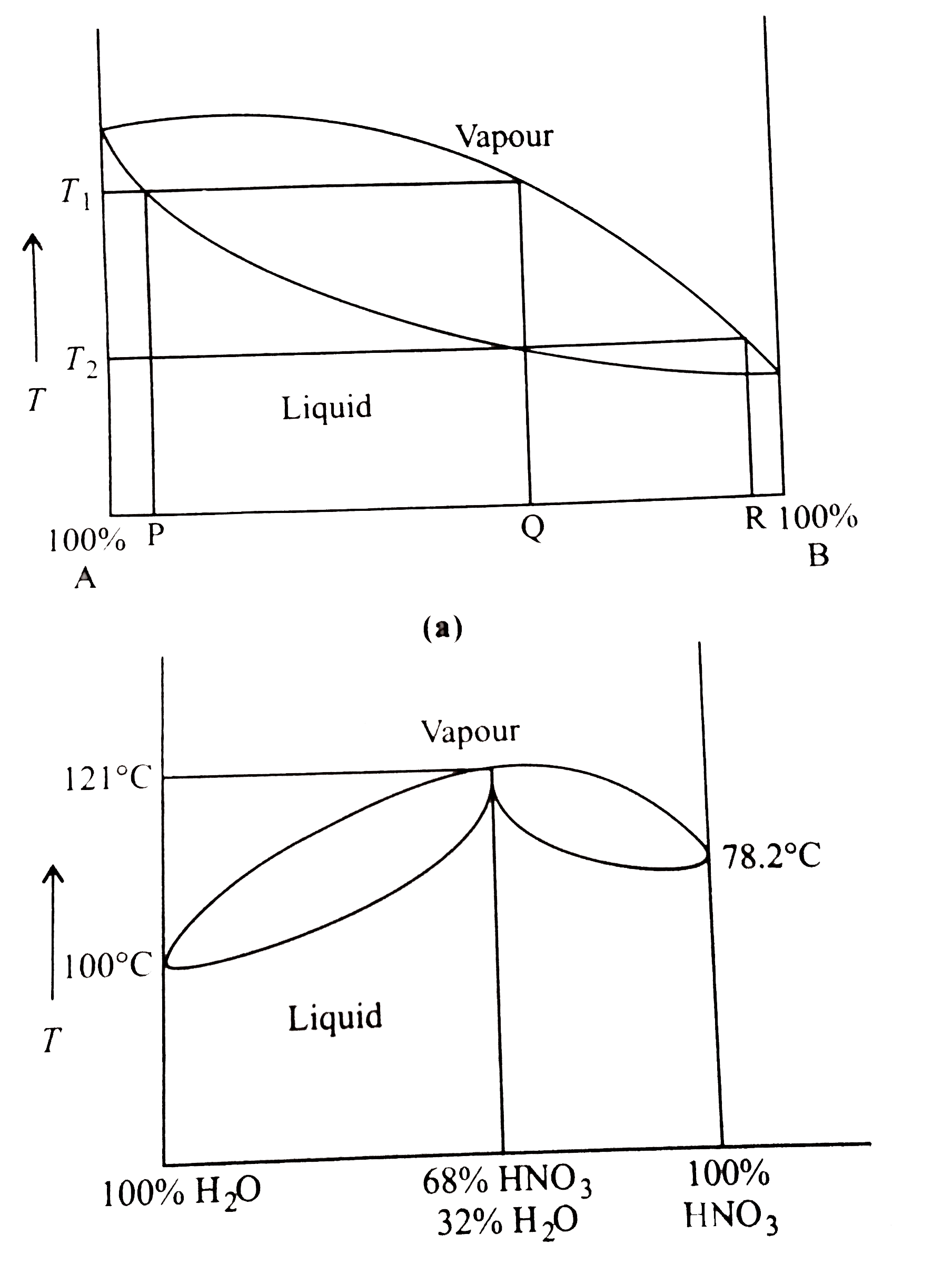 04:31View Solution
04:31View Solutionrepresents the distillation of mixture of liquid `A` and liquid `B` which gives both of pure liquid `A` and `B` . Represents the azeotropic mixture of `HNO_(3)` and `H_(2)O` which distillation gives an azeotropic mixture and either of pure liquid. We cannot separate both the pure liquid, i.e., `H_(2)O` and `HNO_(3)`.
a solution of `50%` of `A` and `50%` of `B` on distillation results into
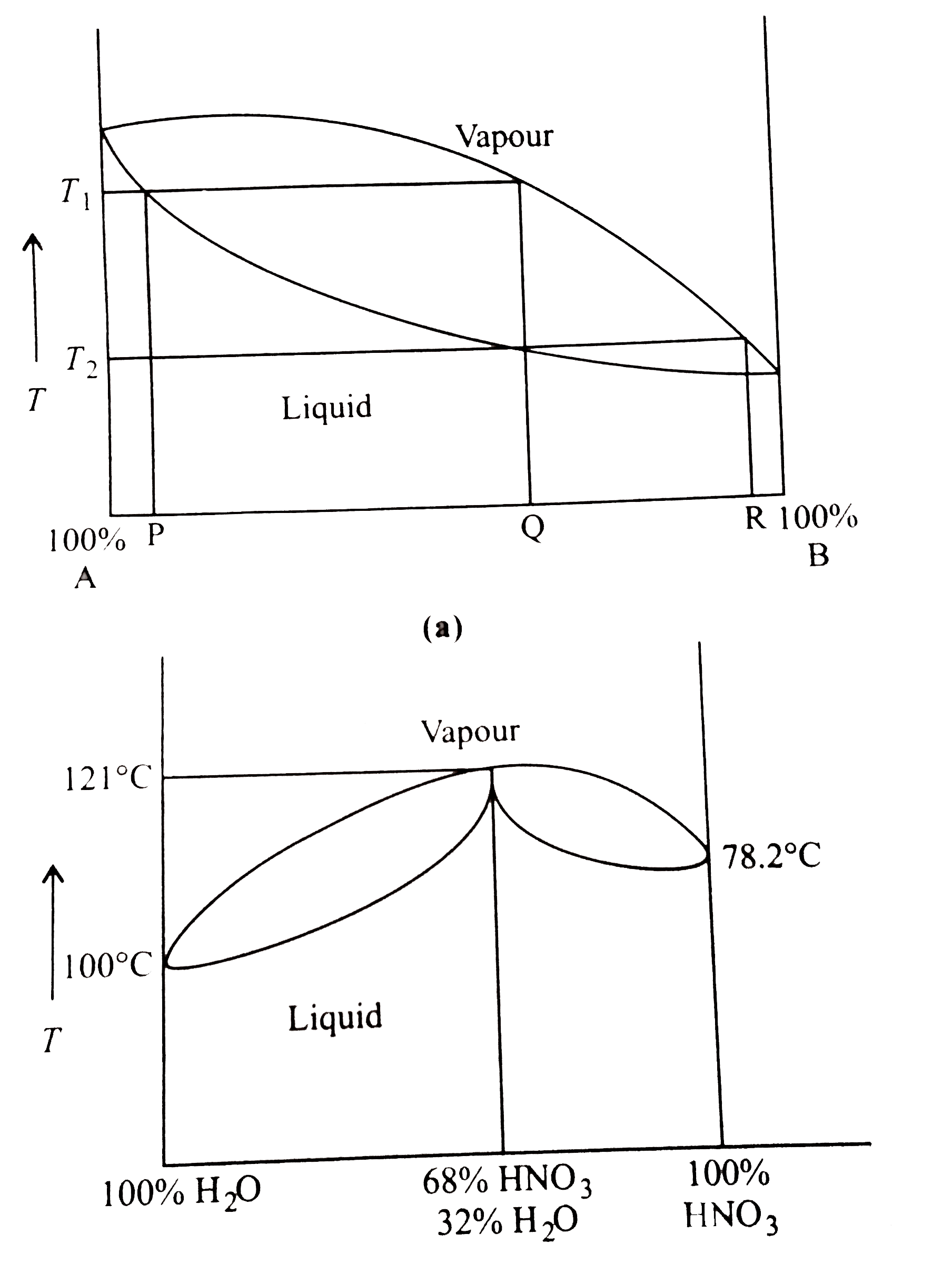
Separation of an azeotropic mixture and pure A .
Separation of an azeotropic mixture and pure B .
Separation of both pure A and pure B .
None of these01:54View Solutionrepresents the distillation of mixture of liquid `A` and liquid `B` which gives both of pure liquid `A` and `B` . Represents the azeotropic mixture of `HNO_(3)` and `H_(2)O` which distillation gives an azeotropic mixture and either of pure liquid. We cannot separate both the pure liquid, i.e., `H_(2)O` and `HNO_(3)`.
At temperature `T_(1)` and composition `Q`, which of the following is true?
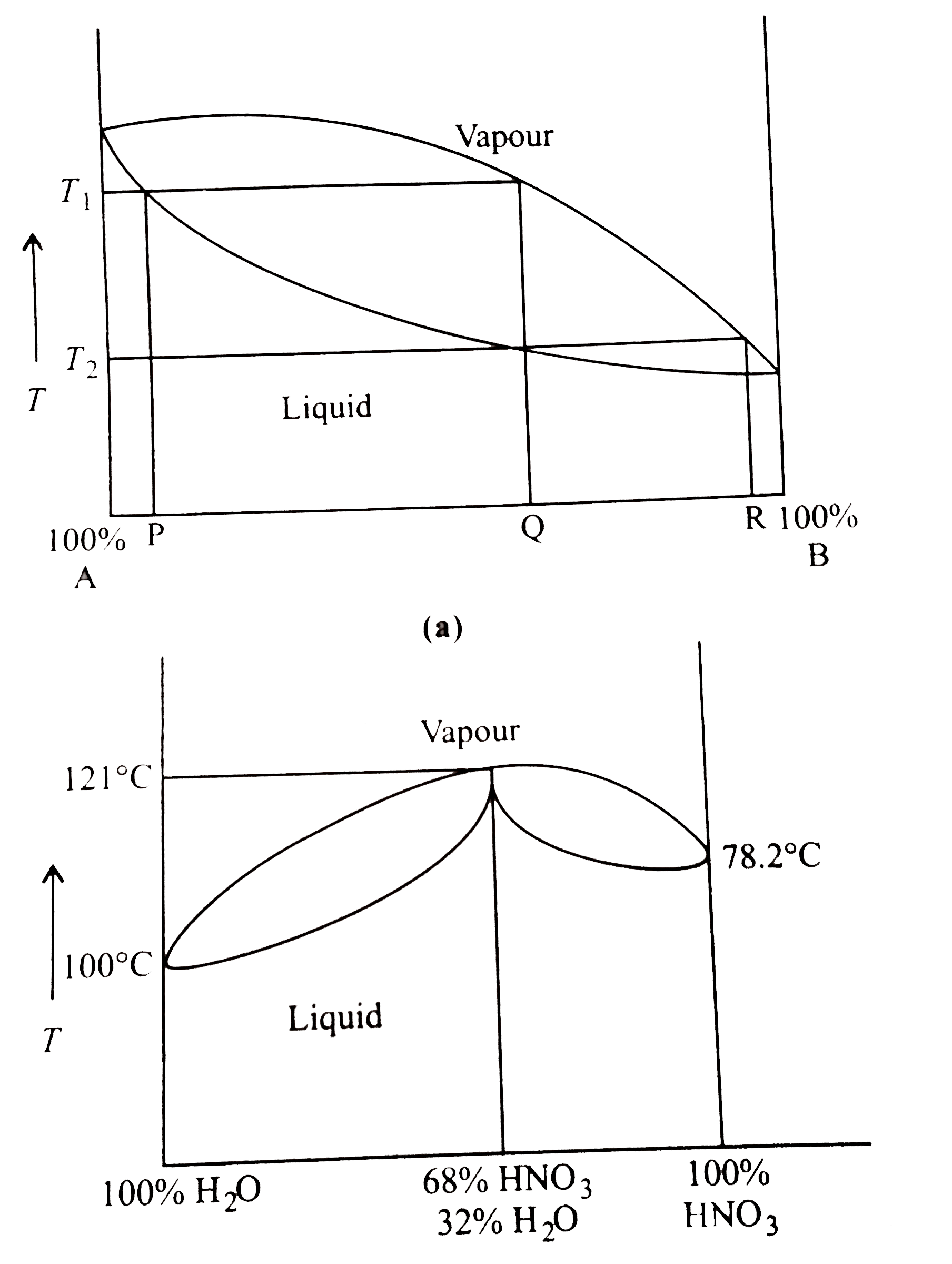
a.Vapour phase is richer in B while liquid phase is richer in A .
b.Distillation of composition Q gives only pure A .
c.Distillation of composition Q gives only pure A and pure B .
d.Distillation of composition Q gives higher percentage of B and A .03:44View Solution
Exercises (Linked Comprehension) questions and complete solutions for chapter SOLUTIONS of CENGAGE CHEMISTRY (ENGLISH) of Class 12
All Exercises from CENGAGE CHEMISTRY Class 12 CHEMISTRY SOLUTIONS
- Ex 2.1 (Objective)
- Ex 2.2 (Objective)
- Ex 2.3 (Objective)
- Exercise (Assertion-Reasoning)
- Exercise (Interger)
- Exercise (True/False)
- Exercise(Fill In The Blanks)
- Exercises (Linked Comprehension)
- Exercises (Multiple Correct)
- Exercises (Single Correct)
- Exercises Archives (Fill In The Blanks)
- Exercises Archives (Integer)
- Exercises Archives (Linked Comprehension)
- Exercises Archives (Multiple Correct)
- Exercises Archives (Subjective)
- Illustration
- Solved Examples
